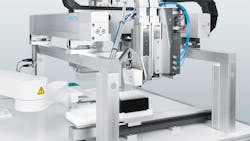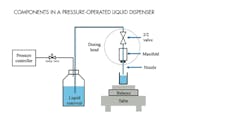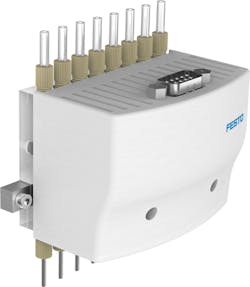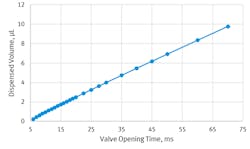Pneumatics in the Lab
What You’ll Learn:
- The benefits of using pressure to dispense fluids in automated labs.
- The basic elements of pressure-controlled dispensers.
- Design considerations when using pneumatic systems.
- A look at some of the systems and products in place today.
From in vitro diagnostics to pharmaceuticals, many biomedical and life science applications depend on precise, repeatable liquid handling. Oftentimes, these processes involve dispensing nanoliter-scale fluid volumes into hundreds of microplates containing up to 1,536 wells. Under these conditions, manual pipetting is imprecise at best and difficult-to-impossible in high-throughput applications. And although liquid handling-robots overcome this challenge, they often include unnecessary features and come with hefty price tags.
Fortunately, there is another option. Pneumatic, pressure-controlled liquid dispensers provide simple, quick, and cost-effective ways to reliably create and dispense precise nanoliter-to milliliter-scale volumes of fluid that are scalable.
Here’s look at the basics of designing pressurized dispensers, including how to manage flow, pressure and other control variables to improve the throughput in these critical applications.
The Challenges of Liquid Control
The ability to control, regulate and measure small volumes of fluids is essential to a variety of biomedical, life science and other automated lab processes—from reagent dosing to handling samples. In these industries, precision is key. In drug discovery applications, for example, a dosing error of only a few percent can render a potential cure ineffective or toxic.
At the same time, delivering liquid samples into microplates and other small vessels comes with its share of challenges. For one, fluid properties and compositions vary widely. For example, viscosities can range from as thin as alcohol to as thick as honey. Fluids can also be highly corrosive, acidic or basic.
To further complicate things, fluid properties can change depending on temperature, dispensing speed, applied pressure and other variables. In addition, dosing these costly, sometimes highly reactive liquids often requires elaborate cleaning procedures between batches to minimize contamination and clogging of wetted parts, and this further drives up costs and downtime.
Pressurized Dispensers
Pressure-operated liquid dispensers are mechanically simple, requiring only a pressure regulator and safety valve, which pressurizes the reservoir containing the liquid, some tubing, a solenoid dispensing valve, and a nozzle to put the liquid into the vessel through a tip with a calibrated orifice.
Flow resistance and pressure largely determine the flow rate. The resistance depends on several variables, including the tube’s inner diameter (ID), length, geometry of the dispensing valve and fittings.
Pressure helps control the fluid velocity as it goes through the dispensing tip. It can be generated by using an external gas source such as nitrogen or by having a compressor pump air into the closed liquid reservoir. Pressures in medical lab fluid dispensers are generally between 100 and 250 millibars, so they are not great safety risks. Nevertheless, dispensers should have safety measures in place to relieve the pressure if there is a leak or other technical failure.
The most important variable affecting flow is the dispensing tip. Working tips (also referred to as channels) can include stationary equipment such as tubes and hypodermic needles. They can also be disposable or made from reusable metal or plastic.
Tip size directly affects the dispensed liquid’s velocity. Unlike pressure and time, which can be controlled and modified using software, the tip cannot. Designers must select the right tip for specific applications. In general, smaller tips provide more fluid-velocity control for a given volume of liquid.
Small tips and high velocities generate better droplet separation, but at the expense of longer dispensing times and possibly some splashing.
Festo, for example, uses needle tips with IDs between 0.3 and 1 mm. This range works well for most fluids and dispense volumes from 1 to 1,000 µl. Depending on the application, custom tips can be developed.
In addition, it’s important for the dispenser’s upstream components to have higher flows as it improves the ability to control dosing speeds and pressure at the tip. If there are flow restrictions upstream, it becomes more difficult to control the flow where it is most important—at the tip.
At Festo, tubing typically has a 2 mm ID while valves and internal passages in manifolds are 1.5 mm or more in diameter. These sizes work well with standard needles and disposable pipette tips.
A solenoid valve and its cycle time determines how much fluid is delivered (the dispense volume). Adjusting the valve’s timing lets operators control dispense volumes. Valves with short, highly repeatable response times offer more precise dispense volumes at higher speeds.
Be advised that the performance of solenoids often change as they heat up. In fact, the first cycle or two of any valve tends to be a few milliseconds slow. That’s why precision dispensers often cycle the valve once or twice before a dispensing run.
Voltage variations can also have a serious effect on repeatability. Some valves, such as Festo’s VYKA, use a low-impedance coil and current control to increase its immunity to voltage variations and work with voltages from 12 to 26 V.
Designers should avoid unnecessary heat generation and short open times on pneumatic dispensers, both of which alter performance. For off-the-shelf valves, open times should not go below 10 msec. Less than 10 msec with off-the-shelf components is generally a bad idea. Care is also needed if times are under 50 msec and precision is required. But it is possible to engineer a highly tuned dispenser with 1 msec open times with appropriate design and control.
Unfortunately, these low heat and short open times can work against each other: Smaller valves generate less heat, but must remain open longer to pass the same volume as larger valves. One way around this is to use electronics to open the solenoid with a short, high-current pull-in pulse, then reduce to a lower hold-in current to keep the valve open. This lowers the total current used by the valve, thus reducing any heating affect.
As a general rule of thumb for pneumatic dispensers, size the tip to get in the right neighborhood for the proper dispense volume, then tune pressure for good droplet separation with no splash. Finally, adjust the solenoid timing to fine tune to the right volume.
Multi-Head Dispensers
One of the biggest benefits of pressure-based dispensers is their scalability. It’s easy to combine several dispensing heads by mounting them on a rail or retaining plate to create multi-channel dispense heads that handle different volumes, fluids, and pressures.
When it comes to multi-channel dispensers, small differences among inlets, valves and nozzles can cause some channels to dispense higher volumes than others, leading to intrinsic tip-to-tip variability on the order of 4%. At resolutions of 1 ms or higher, it’s difficult to compensate for these small variations using whatever processor is controlling the solenoid dose time. A better course of action is to calibrate separate channels by varying the pull-in and hold-in solenoid current so that all channels dispense the same quantity using the same dispense times.
Pressurized liquid dispensers can improve throughput in automated lab applications by providing a mechanically simple, cost-effective way to dose nanoliter-scale fluid volumes with speed, precision and reliability. They let engineers easily build higher-level liquid handling equipment at a fraction of the cost of complex robotics.
Pneumatics in Action
VTOE Dispensing Heads
This dispenser contains eight open-loop pipettes and VTOE dispense heads on a single rail, which lets different fluids and volumes be dispensed in parallel. VTOE dispense heads are highly precise when working with small fluid volumes. As indicated by gravimetric tests, the head has high linearity over a wide range of impulse times—indicating high precision with a coefficient of variation (CV) < 1% from 10-1,000 µl.
PGVA
The PGVA pressure/vacuum generator from Festo handles pressure for an automated pipettes and lets it pickup and deliver liquid volumes in milliliter ranges and up with ±2% precision. Pressure and vacuum are generated by a 50 dB pump and stored internally in individual reservoirs. Air is filtered to 0.001 µm purity. Flow is servo-controlled by an accurate and fast energy efficient piezoelectric regulator with an extremely long life.
The compressor, proportional control, air filter, silencer, pressure/vacuum reservoirs, pressure sensor and 24 V power supply fit in an enclosure that measures 8 × 3 × 8 in. For all intents and purposes, the filer never needs to be replaced. But the industrial filter cartridge and be replaceable if the unit is used in extreme environments.
Open-loop Pipettes
Open-loop pipettes such as these from Festo can be used for pressure-over-liquid aspirating and dispensing in automated equipment systems. Up to 96 can be combined for high-volume applications. Sensors detect changes in pressures from one dispensing cycle to the next to automatically detect clogged tips. Sensors can also detect the small change in flow when a tip gets close to a liquid surface, letting it accurately and repeatably determine the liquid level in a vial or container.
These open-loop pipettes have no sensor feedback for performance. They have no way to detect environmental changes such as pressure or temperature. They are uncalibrated and depend on the operator to adjust parameters (pressure, time) to achieve the required transfer volumes.
By the end of 2022, Festo will offer closed-loop pipettes. They are programmed using a built-in web interface and will be targeted at applications that require high levels of accuracy. They will be outfitted with several sensors and feedback loops that let them verify and adjust volumes.
Sam Stoney is the industry segment manager and Joshua Lamontagne is product market manager for Life Sciences at Festo.
About the Author
Sam Stoney
Industry Segment Manager, Life Sciences, Festo
Sam Stoney is the industry segment manager for Life Sciences at Festo.
Joshua Lamontagne
Product Market Manager, Life Sciences, Festo
Joshua Lamontagne is product market manager for Life Sciences at Festo.

Leaders relevant to this article:







